Overview
The one-hour program aired on Sunday, December 8, 1957, live from CBS Studio 58, the Town Theater at 851 Ninth Avenue in New York City. [1] [2] [3] [4] [5] [6] [7] The show was hosted by New York Herald Tribune media critic John Crosby, directed by Jack Smight, and produced by Robert Herridge. Jazz writers Nat Hentoff and Whitney Balliett were consultants.
The Sound of Jazz features performances by musicians from the swing era, including Count Basie, Lester Young, Ben Webster, Billie Holiday, Jo Jones, and Coleman Hawkins; Chicago-style players of the same era, such as Henry "Red" Allen, Vic Dickenson, and Pee Wee Russell; and modern jazz musicians such as Gerry Mulligan, Thelonious Monk, and Jimmy Giuffre. [8] These players played separately but also joined to combine styles in one group, such as Red Allen's group and the group backing Billie Holiday on "Fine and Mellow". The show's performance of "Fine and Mellow" reunited Holiday with her friend Lester Young for the final time. Jazz critic Nat Hentoff recalled that during rehearsals Holiday and Young kept to opposite sides of the room. Young was very weak, and Hentoff told him to skip the big band section of the show and that he could sit while performing in the group with Holiday.
During the performance of "Fine and Mellow", Webster played the first solo. "Then", Hentoff remembered:
Lester got up, and he played the purest blues I have ever heard, and [he and Holiday] were looking at each other, their eyes were sort of interlocked, and she was sort of nodding and half–smiling. It was as if they were both remembering what had been—whatever that was. And in the control room we were all crying. When the show was over, they went their separate ways. [9]
Within two years, both Young and Holiday had died.
Noting that the cameras were employed as "straight reportorial tools", Jack Gould observed in a review in The New York Times , "It was the art of video improvisation wedded to the art of musical improvisation; the effect was an hour of enormously creative and fresh TV." [10]
The album version of The Sound of Jazz telecast is derived from a rehearsal (recorded on December 4) that preceded the telecast held at Columbia's 30th Street studios) and is not the soundtrack. The album was released by Columbia in 1958. The recording does not include all of the performers present on the telecast (Mulligan refused to participate because no additional payment was involved) and includes several who were not on the show. Bassist Walter Page rehearsed and is featured on the album, but he collapsed on the way to the studio for the telecast.
This page is based on this
Wikipedia article Text is available under the
CC BY-SA 4.0 license; additional terms may apply.
Images, videos and audio are available under their respective licenses.
